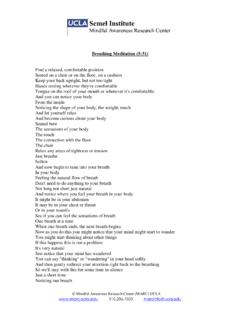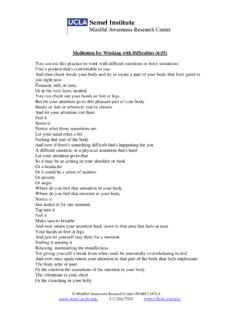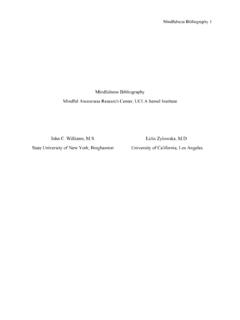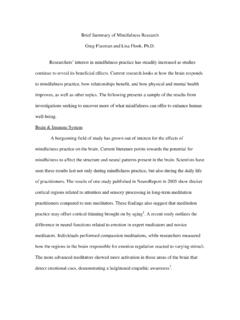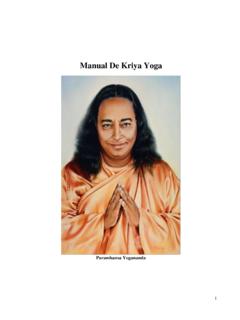Transcription of An Introduction to Kundalini Yoga Meditation …
1 PRACTICETHE JOURNAL OF ALTERNATIVE AND COMPLEMENTARY MEDICINEV olume 10, Number 1, 2004, pp. 91 101 Mary Ann Liebert, Introduction to Kundalini yoga Meditation Techniques ThatAre Specific for the Treatment of Psychiatric DisordersDAVID S. SHANNAHOFF-KHALSAABSTRACTThe ancient system of Kundalini yoga includes a vast array of Meditation techniques and many were dis-covered to be specific for treating the psychiatric disorders as we know them today. One such technique wasfound to be specific for treating obsessive-compulsive disorder (OCD), the fourth most common psychiatricdisorder, and the tenth most disabling disorder worldwide. Two published clinical trials are described here fortreating OCD using a specific Kundalini yoga protocol. This OCD protocol also includes techniques that areuseful for a wide range of anxiety disorders, as well as a technique specific for learning to manage fear, onefor tranquilizing an angry mind, one for meeting mental challenges, and one for turning negative thoughts intopositive thoughts.
2 Part of that protocol is included here and published in detail elsewhere. In addition, a num-ber of other disorder-specific Meditation techniques are included here to help bring these tools to the attentionof the medical and scientific community. These techniques are specific for phobias, addictive and substanceabuse disorders, major depressive disorders, dyslexia, grief, insomnia and other sleep paper refers to the system of Kundalini yoga astaught by Yogi Bhajan, a living master of Kundaliniyoga, Hatha yoga , and White Tantric yoga . In December1968, Yogi Bhajan left India to come to the West to teachwhat he had learned to those with a spiritual hunger, an in-terest to explore altered states of consciousness withoutdrugs, and to help implement novel treatment modalities forhealth care and the enhancement of life. When he arrivedhe stated his mission: I have come to create teachers, notto gather disciples.
3 Determined to train leaders and teach-ers with the power to heal, uplift, and inspire humanity, hetaught Kundalini yoga openly to the public, breaking the tra-dition of secrecy that had surrounded it for thousands ofyears (Bhajan, 1997). Since that time he has taught nearly5000 different Meditation techniques, of which many havebeen taught that were known by yogis to be specific for dis-tinct psychiatric disorders. These disorders as we know themtoday have no doubt been common to humanity since theorigin of the author first began to learn Kundalini yoga in 1974,and during his early training as a Kundalini yoga teacher,in addition to numerous other Meditation techniques, helearned a Kundalini yoga breathing Meditation techniquespecific for the treatment of obsessive-compulsive disorder(OCD). This technique was first published in a scientific textin 1991 (Shannahoff-Khalsa, 1991).
4 In that text Kundaliniyoga Meditation techniques were also taught that were spe-cific for treating anxiety, fatigue, stimulating the immunesystem for treating solid tumors, expanding and integratingthe mind, developing a comprehensive, comparative and in-tuitive mind, and one for regenerating the central nervoussystem. In 1992, the author had his first opportunity to at-The Research Group for Mind Body Dynamics, Institute for Nonlinear Science, University of California, San Diego, La Jolla, CA,and The Khalsa Foundation for Medical Science, Del Mar, treatment of individuals with OCD in an open non-placebo-controlled clinical trial. This trial led to funding bythe Office of Alternative Medicine at the National Institutesof Health for conducting a randomized controlled partiallydouble-blinded trial comparing this Kundalini yoga proto-col against a group using two common Meditation tech-niques.
5 These trials are described addition, techniques are included (after the material onOCD) for treating addictive disorders, depression, grief,learning disorders, phobias, and sleep disorders, respec-tively. However, the latter techniques have not yet been sub-mitted to controlled clinical trials, but have been used byyogis for thousands of years for treating the respective dis-orders. Also, the author has anecdotal evidence of their ef-ficacy. Nonetheless, there is a strong calling for rigorouscontrolled clinical trials to test TREATMENT OF OCDOCD is one of the most disabling of the anxiety disor-ders and is likened to a waking nightmare (Rapaport,1990). Rasmussen and Eisen (1990) state that OCD has alifelong prognosis and is the fourth most common psychi-atric disorder after phobias, substance abuse, and the majordepressive disorders, and is twice as common as schizo-phrenia and panic disorder.
6 OCD often begins during child-hood or adolescence and has a lifetime prevalence rate (Rasmussen and Eisen, 1990). According toMurray and Lopez (1996), OCD is also among the top 10causes of disability worldwide. OCD is not responsive totraditional insight-oriented psychotherapy (Jenike, 1990)and is considered to be one of the most difficult psychiatricdisorders to conventional treatment modalities are psychophar-macologic and cognitive behavior therapy (CBT) in the formof exposure and response prevention. Unfortunately, neitheroffers quick relief to reduce the anxiety-provoking obses-sions and compulsions that are the troubling marker of OCD is classified as an anxiety disorder, its rate ofsymptomatic response to medication is much slower thanother anxiety-related disorders. In addition, 40% 60% ofpatients exhibit only minimal improvement or no changewith serotonin re-uptake inhibitors alone (Goodman et al.)
7 ,1992), and as many as one third are unimproved after ap-parently adequate drug treatment (Goodman et al., 1992), yielding the drug treatment resistant patient. In respon-ders, medication produces only a 30% 60% symptom re-duction and patients tend to remain chronically symptomaticto some degree despite the best of pharmacologic interven-tions (Jenike, 1992), and a 20% 35% decrease in meanYale-Brown Obsessive Compulsive Scale (Y-BOCS) scoresmay represent a clinically meaningful change in symptomseverity, clearly leaving room for improvement (Goodmanet al., 1992). When medications work they usually take ap-proximately 2 4 weeks to begin to show improvement, andCBT can take even longer. One advantage of CBT over med-ication is that the results last much longer once discontin-ued (Hembree et al., 2003). Discontinuation of pharmaco-logic treatment is, however, almost always associated witha complete relapse (Cheslow et al.
8 , 1991; Fontaine andChouinard, 1989; Pato et al., 1988). When patients are re-mitted on medications and stop using them, their symptomsalmost always revert to their original severity. However, Kundalini yoga can be used to produce both quick tempo-rary relief as well as long-term improvement and case study of quick temporary relief is presented in Shan-nahoff-Khalsa (2003a) along with a review of prior Kun-dalini yoga year-long clinical trials have been conducted to testthe efficacy of Kundalini yoga Meditation techniques for thetreatment of OCD. The first trial was an open uncontrolledpilot (Shannahoff-Khalsa and Beckett, 1996), and the sec-ond was a randomized controlled trial (Shannahoff-Khalsa,1997, 2003a, 2003b; Shannahoff-Khalsa et al., 1999). Thefirst trial was conducted in an attempt to test a techniquethat was claimed by yogis to be specific for the treatmentof OCD (Shannahoff-Khalsa, 1991).
9 The second trial wasconducted to include a comparison Meditation group usingthe well-studied Relaxation Response technique (Benson,1975) along with the Mindfulness Meditation technique (Ka-bat-Zinn, 1990) for 30 minutes each to approximate the timefor the Kundalini yoga protocol, to in part control for theexpectations of Meditation per seand for the effects ofpersonal attention by a therapist in a group PILOT STUDY: AN OPENUNCONTROLLED TRIALIn a small uncontrolled trial (Shannahoff-Khalsa andBeckett, 1996), in which five of eight patients completed a12-month trial, the group showed a mean Y-BOCS im-provement of going from a total score of at base-line to at 12 months. The Symptom Checklist-90-Re-vised (SCL-90-R) (Derogatis, 1993), Obsessive Compulsive(OC) scale, and Global Severity Index (GSI) showed meanimprovements of and , respectively, for the fivecompleters. These five were all previously stabilized withfluoxetine (20 40 mg) for longer than 3 months prior to thestart of the study.
10 Of the five, three were completely free ofmedication for at least 5 months prior to the end of the 12-month study and the other two were significantly reducedby 50%. One year later, four of the five subjects had beenoff medication for periods between 9 and 19 months withlasting improvement. The three who had dropped out earlywere all unmedicated and had each completed the first 3-month mark for therapy. Their Y-BOCS totals went from amean of to While these findings of sustained andclinically significant improvement in the five completers SHANNAHOFF-KHALSA92were obtained in an uncontrolled Meditation trial, placeboeffects with OCD patients are usually low. A 3% 13%placebo effect was observed in a clomipramine-placebo dou-ble-blinded controlled study (Griest et al., 1990). A morerecent multicenter double-blinded placebo-controlled flu-voxamine study showed a Y-BOCS improvement forthe drug and a 7% placebo improvement (Goodman et al.)
